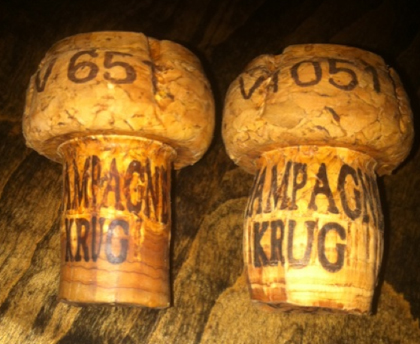Dr Vino's wine blog
wine talk that goes down easy
Pierre Peters champagne with Rodolphe Peters
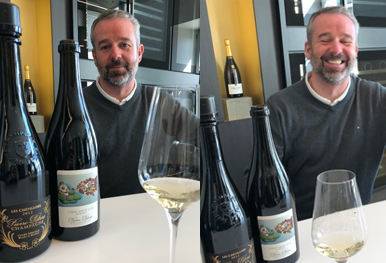
One winery I wanted to be sure to visit when I was in Champagne last month was Pierre Péters. I have always tremendously enjoyed the racy wines in the US and Rodolphe Péters not only commands a lot of respect in the wine world for his Champagnes but I had heard he had a new (sparkling) wine project in California I wanted to learn more about. Despite wanting to find it, I drove right by the winery in Le Mesnil-sur-Oger–there’s no sign and it looked like a construction site.
Rodolphe Péters, who has made the wine since taking over from his father in 2007, met me and apologized for the mess. He said the project was taking longer than expected (which renovation hasn’t?). Rodolphe is a sixth generation farmer and a fourth generation winemaker. The estate is a renowned producer of blanc de blancs Champagne from their 19.98 hectares, which contain 65 parcels on the thin topsoil and chalky subsoil of the famed Cote des Blancs area. Only his grand cru wines are available in the US market (While he does make wine that is not grand cru, that stays in the French domestic market and the US receives only grand cru wines.
Rodolphe graduated as an enologist in 1992 but didn’t dive right in to Read more…
Warriors toast NBA title with actual champagne!
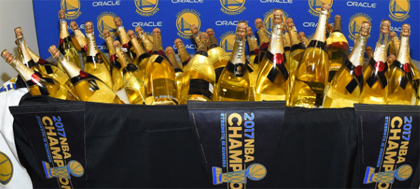
The Golden State Warriors won their second NBA title in three seasons last night. As a hoops fan, the most impressive stat for me was 147 assists on 216 made baskets–teamwork! But as a wine geek, we here at the Dr. Vino World Headquarters had to wonder…what would the team pop to celebrate in the locker room?
Would the owners cheap out as so many MLB owners do and use bubbly that could be picked up at any 7-11 on the way to the stadium?
We asked a Russian to hack the feed from the locker room to see what they sprayed. (Okay, our source was actually ESPN’s Darren Rovell.) This Warriors team did not hold back! To celebrate this title the doused each other with magnums (natch) of Moët Impérial “Golden Luminous”–a limited edition of the Moet nonvintage that Rovell says are valued at $1,200 each. (Search for this wine) Given the size of the ice bucket, that could have set the owners back about $200k, if the bubbly wasn’t donated by LVMH.
If you want to celebrate in a similar style, the “regular” Moet Imperial is about $40. Or get a more singular wine with a grower Champagne for the same price. (Or even a new wave sparkler from the Golden State!) And throw in a Warriors Champions locker room towel for $17.99 and you can have a similar experience for a fraction of the price. Ski goggles optional. Read more…
Champagne Jacquesson
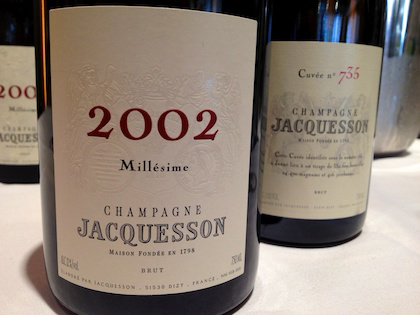
A pair standout champagnes I tasted this fall were from Jacquesson, a small house in Dizy run by the brothers Jean-Hervé and Laurent Chiquet (brothers of Gaston). Jacquesson has a number of interesting things going on as they drive toward distinction. First, they are making only one wine that is a blend of sites, their nonvintage “700” series cuvée. (No, this isn’t a BMW.) Each NV blend has a different base wine each year and thus gets a different number. The “735” that I tasted draws 72% of the wine from the 2007 vintage, with the remainder from reserve stocks. It has beautiful poise, a bready aroma balancing on a sprightly core of acidity.
Second, the 2002 is the end of the line for multi-site vintage wines at Jacquesson. From here on out, they will be doing only site-labeled vintage cuvées (there weren’t any of those at the walk-around tasting I attended), no multi-site vintage wines. As you might expect, given the vintage, the 2002 was serious stuff, with more depth and complexity than the sprightly “735,” but still tightly wound stoniness with many years ahead of it.
Third, the labels are terrific. The back label is possibly Read more…
A vote against disgorgement dates: Peter Wasserman
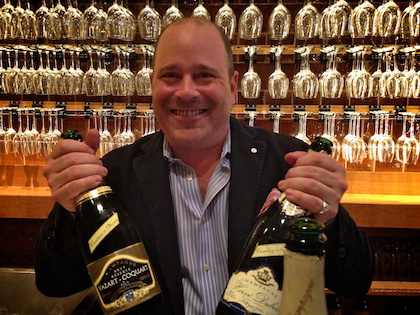
In the ongoing debate about whether champagnes should have disgorgement dates on the labels, discussion has mostly been in favor of the practice. Some critics refuse to review a nonvintage wine without a disgorgement date. (What is disgorgement?)
At the portfolio tasting of Pas Mal Selections in New York last month, Peter Wasserman expressed hesitations about the sole focus on disgorgement dates. Peter works for Becky Wasserman Selection aka Le Serbet (his business card reds “head of anti-marketing and sales prevention”), the Burgundy-based exporter that represents almost 20 Champagnes. He said that the disgorgement date alone doesn’t reveal anything about the base wine, which vintage it is or how long the wine has been on the lees. Nor does it say whether the wine has been aged in the bottle with a cork closure or a bottle cap. He estimates some of his growers disgorge 20 times per wine, so if a critic reviewed only one disgorgement date and consumers sought out only that one, he would be at a “commercial disadvantage.” Thus he has invited critics interested in including disgorgement dates to review a wine from each disgorgement date. “They do it for Jacques Selosse,” he says.
For nonvintage cuvées, Wasserman favors the vintage of the base wine as the most important information for consumers. Thus the champagnes of Le Serbet will have the base wine and the year of disgorgement on the label (though not all of his US distributors were on board with this at the time we spoke). More information will be available about each wine on the Le Serbet web site, a good move to engage the tiny percentage of consumers who care to find out more.
While he prefers more information on the label, he feels that the focus on disgorgement dates can lead consumers to seek out the freshest. That’s unfortunate, since, in his view, many retailers have excellent storage and nonvintage cuvées are complex, often tasting better with one or two years on the cork.
Are you for Champagne disgorgement dates? We are!
When you’re shopping for bubbly between now until New Year’s Eve, how will you know how long that nonvintage bottle has been on the shelf? If there were a disgorgement date on the label, you would have a better clue.
Over the weekend, Jancis Robinson tasted two Krug Grande Cuvée wines and commented on Twitter how different they were. Antonio Galloni of Robert Parker’s The Wine Advocate replied to her that the WA has not reviewed Champagne without a disgorgement date since 2009. (See exchange below.) Jon Bonné of the San Francisco Chronicle wondered how many writers it might take to adopt the same policy to force the producers’ hand in the region. It’s a stick approach.
Here’s a carrot for the producers: disgorgement dates will engage the most interested consumers. These are the ones that should be of particular interest to producers since they would look up further information on the producer web site and alert their world to their experience (good or bad) via social media.
Disgorgement dates are important. After the jump, check out Champagne writer Peter Liem, who is pro-disgorgement labeling, giving his reasons why they are important. I’m in favor of Champagne producers putting some sort of legible, comprehensible form of disgorgement dates on the (back) label. If you are too, hit the comments! Read more…
Mark Cuban, white Burgundy, NYC event — sipped & spit
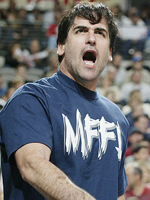 SIPPED: bling
SIPPED: bling
Mark Cuban, the owner of the Dallas Mavericks, celebrated the team’s NBA victory by ordering a $90,000 of Ace of Spades Champagne. No word on the exact size of the “huge” bottle, but I’m sure it was drained faster than you could say Salamanzar. While congratulations are in order for the Mavs’ victory of the Heat, the mere idea of spending $90,000 on a bottle of nonvintage Champagne really does make one wonder if Cuban is trying to make the idea of a billionaires’ tax seem like a worthy idea. Of note: he did leave a $20,000 tip. [MSN]
SIPPED: mo money
More Bordeaux 2010 prices have been released. Tim Atkin discusses one broker who said “enough is enough” when it came to Ruazan-Segla. And Mike Steinberger launches a discussion on why there’s no outrage about high Burgundy prices.
SIPPED: white Burgundy, 2008 edition
The ’08 white burgundies get some love from Eric Asimov. But, shh, don’t tell anybody because then the remaining wines in the market will get hoovered up! [NYT]
SIPPED: lots of Woodbridge
Richard Sands, CEO of Constellation Brands (owner of Robert Mondavi among others) made $8.43 million in FY2011. Robert Sands, his brother and chairman, made $7.79 million. Did they pop any Ace of Spades? [ABC]
SIPPED: Dr. Vino
I’m giving a free, public talk next week at the New School about my book Wine Politics. And it even made the Times Dining calendar!
BREAKING: Jay-Z profits from Armand de Brignac!
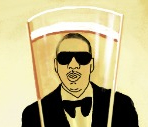 In an extensive waste of the journalism world’s precious resources, Zack O’Malley Greenburg has uncovered what we have known since 2006: Armand de Brignac is mediocre Champagne at best and Jay-Z profits from it!
In an extensive waste of the journalism world’s precious resources, Zack O’Malley Greenburg has uncovered what we have known since 2006: Armand de Brignac is mediocre Champagne at best and Jay-Z profits from it!
Greenburg has a chapter of his forthcoming book on Jay-Z published in The Atlantic (although, mysteriously, it has been removed from their site and is available here). As we discussed back in 2006 (“Jay-Z puts an Ace in play“), drawing on stories in the WSJ and BusinessWeek, “Ace” is an absurdly priced nonvintage Champagne that came out of nowhere and relies on Jay-Z’s star power to sell it. If he has a financial stake in it, so what? People who buy it are overpaying to drink image rather than a quality wine, hardly the first time that has happened.
Here’s how Lyle Fass summed it up in Greenburg’s piece: “Everybody should take a lesson who wants to sell wine that sucks. Because it is probably the most brilliant marketing in the history of wine.”
Previous Ace coverage: Jay-Z puts an Ace in play
Reader mailbag: finding Ace of Spades champagne
Ace of Spades expands into a full house
Douchebauchery chronicles
Divers find old champagne and immediately chug it
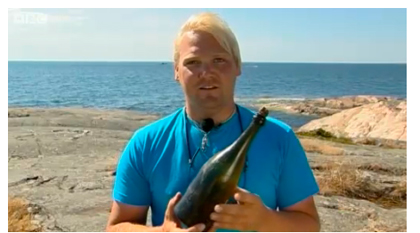
Nordic divers have found a cache of old champagne bottles on a shipwreck in the Baltic Sea. Christian Ekstrom (pictured above via BBC) and his dive partners could not contain their enthusiasm at finding the intact bottles that may date from the late 18th century. So they brought one to the surface, uncorked it, and had a swig. Which statement below captures their reaction?
A) “Damn, it’s only nonvintage yellow label, which hardly keeps from one Christmas to the next. Oh, and the bloody thing is corked!”
B) “It was fantastic… it had a very sweet taste, you could taste oak and it had a very strong tobacco smell. And there were very small bubbles.”
Well, if you guessed (B) then you are right! I personally hate it when the oak doesn’t integrate after 220 years though.
In shades of Rodenstockian abundance, a Reuters story says that the diver does not yet know the number of bottles in the cache. The same story quotes Champagne expert Richard Juhlin saying that he thinks it is late-18th century, from the Clicquot house, and valued at about $68,000 a bottle.
Related: “Cristal at 20,000 leagues under the sea“
